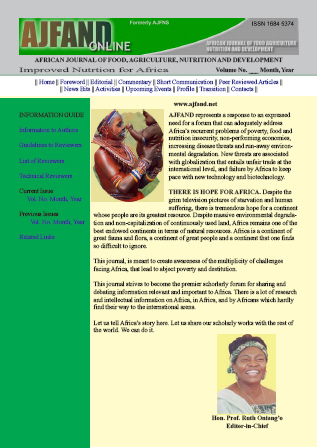
|
African Journal of Food, Agriculture, Nutrition and Development
Rural Outreach Program
ISSN: 1684-5358
EISSN: 1684-5358
Vol. 16, No. 4, 2016, pp. 11278-11294
|
 Bioline Code: nd16063
Bioline Code: nd16063
Full paper language: English
Document type: Special Article
Document available free of charge
|
|
|
African Journal of Food, Agriculture, Nutrition and Development, Vol. 16, No. 4, 2016, pp. 11278-11294
| en |
CHANGES IN PHYSICO-CHEMICAL CHARACTERISTICS AND VOLATILE FLAVOUR COMPONENTS OF DIFFERENT YOGHURT PRODUCTS MADE FROM SOY, PEANUTS AND COW MILK
Kpodo, F; Afoakwa, E; Saalia, K & Amoa, B
Abstract
Milk blends from legumes are potential nutritional substitutes in cultures where cow milk is used for yoghurt production. Peanut and soy based products have been considered to have poor sensory characteristics due to the beany and off-flavours they generate in food products that contain them. The high polyunsaturated fatty acid content of legumes makes these products susceptible to lipid oxidation leading to rancidity and development of off-flavours. Acceptability ratings of these products have been significantly lower than the traditional dairy products. Nonetheless, food scientists are still faced with the challenge of formulating foods that are appealing and acceptable to consumers, but still contain significant amounts of these oilseed proteins for their health benefits. The development of a storage stable yoghurt product from these vegetable seeds has the potential to increase utilization and market for peanut and soy beans. The study investigated the keeping quality of Soy-peanut-cow milk yoghurt (SPCY), Defatted peanut-soy milk yoghurt (DPSY) and Cow milk yoghurt (CMY) refrigerated at 5°C over a period of 21 days during storage. Volatile flavor compounds in the different yoghurt samples were determined by static head space technique using Gas Chromatography-Mass Spectrometer (GC-MS). Titratable acidity increased in all samples after one week of storage but was highest in CMY (1.2% - 2.60%) followed by DPSY (0.57% - 0.89%). SPCY had the least titratable acidity value (0.23% - 0.44%). CMY and DPSY were more susceptible to syneresis. Free fatty acid (FFA) and peroxide value (PV) were high in the full fat product compared to defatted product and cow milk yoghurt. Flavour analysis using GC-MS identified aldehydes, alcohols, organic acids and furans as the volatile flavour components in the yoghurts studied. The defatted vegetable milk yoghurt (DPSY) had better storage keeping qualities than the whole fat vegetable milk yoghurt (SPCY) and the control (CMY). Defatting of oilseeds prior to use in food formulations can enhance the storage stability of the products. Utilization of less expensive and available indigenous crops such as soy beans and peanut in yoghurt production will help reduce the cost of the product in some developing countries.
Keywords
Vegetable milk yoghurt; storage characteristics; volatile flavour compounds
|
| |
© Copyright 2016 - African Journal of Food, Agriculture, Nutrition and Development
Alternative site location: http://www.ajfand.net/
|
|
